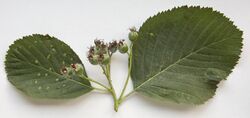Biology:Aria eminens
| Aria eminens | |
|---|---|

| |
| Leaves and unripe fruit from a small tree in Sutton Park, England | |
| Scientific classification | |
| Kingdom: | Plantae |
| Clade: | Tracheophytes |
| Clade: | Angiosperms |
| Clade: | Eudicots |
| Clade: | Rosids |
| Order: | Rosales |
| Family: | Rosaceae |
| Genus: | Aria |
| Species: | A. eminens
|
| Binomial name | |
| Aria eminens (E.F.Warb.) Sennikov & Kurtto
| |
| Synonyms | |
| |
Aria eminens, commonly known as the round-leaved whitebeam,[2] is a species of plant in the family Rosaceae. It is endemic to Great Britain and is threatened by habitat loss.
Description
Aria eminens is broadly similar to Aria edulis. It is a shrub or small tree up to 10 m (33 ft) tall. The undersides of the leaves are greyish-white due to the many hairs. The leaves are more or less round, usually with a length 1–1.3 times the width, rarely up to 1.5 times as long as wide; they usually have 9–11 veins on either side. The leaf margins usually have a single series of teeth ("uniserrate") although there can be evidence of a second series ("biserrate"). The fruits have many lenticels, small and large, mainly towards the base.[3]
Distribution and habitat
Aria eminens is endemic to parts of south-west England and south Wales. It is considered to be native to calciferous woodland in north Somerset, west Gloucestershire, Herefordshire and Monmouthshire.[3] It has also been recorded in Sutton Park, Birmingham, well outside its expected range, where it is assumed to have been planted originally.[4]
Evolution
A. eminens is a tetraploid, resulting from hybridisation between Aria edulis and Aria porrigentiformis[5]
References
- ↑ Rivers, M.C.; Beech, E. (2017). "Sorbus eminens". IUCN Red List of Threatened Species 2017: e.T34728A80736113. doi:10.2305/IUCN.UK.2017-2.RLTS.T34728A80736113.en. https://www.iucnredlist.org/species/34728/80736113. Retrieved 16 November 2021.
- ↑ (xls) BSBI List 2007, Botanical Society of Britain and Ireland, https://bsbi.org/download/3542/, retrieved 2014-10-17
- ↑ 3.0 3.1 Stace, Clive (2010). New Flora of the British Isles (3rd ed.). Cambridge, UK: Cambridge University Press. ISBN 978-0-521-70772-5. p. 209.
- ↑ Trueman, Ian; Poulton, Mike; Reade, Paul (2013). Flora of Birmingham and the Black Country. Newbury, Berks: Pisces Publications. ISBN 978-1-874357-55-1. p. 271.
- ↑ Robertson, A., Rich, T.C., Allen, A.M., Houston, L., Roberts, C.A.T., Bridle, J.R., Harris, S.A. and Hiscock, S.J., 2010. Hybridization and polyploidy as drivers of continuing evolution and speciation in Sorbus. Molecular Ecology, 19(8), pp.1675-1690.
Wikidata ☰ Q1326398 entry
 |


